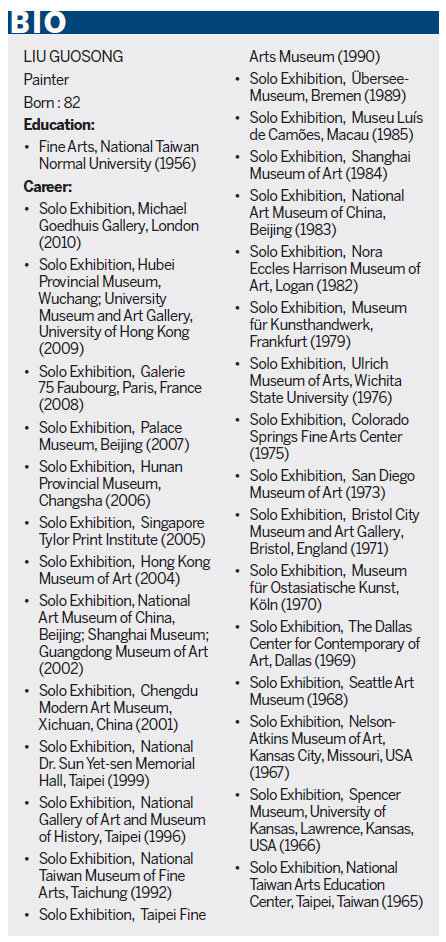
|
Currently a chaired art professor at National Taiwan Normal University, Liu Guosong is universally recognized as one of the earliest and most important advocates and practitioners of modern Chinese painting. His artworks are collected and shown by museums and art galleries in more than 70 countries, and he has been featured in more than 100 solo exhibitions worldwide. Qidong Zhang / China Daily |
Currently a chaired art professor at National Taiwan Normal University, Liu Guosong is universally recognized as one of the earliest and most important advocates and practitioners of modern Chinese painting. His artworks are collected and shown by museums and art galleries in more than 70 countries, and he has been featured in more than 100 solo exhibitions worldwide.
Liu started his art studies in college, learning the skills and techniques of brush and ink. By his second year in college, however, he started to question the nature of this practice. He saw that from the Yuan dynasty (1271-1368) onwards, the imitation of ancient modes had become a popular trend, which further evolved into a tradition. Chinese painting had witnessed no technical innovation or development since then. Instead it was on a narrow path, leading to decline.
"I felt like I was heading into a dead end," Liu said. "My doubts led me to the decision to give up the study of traditional ink painting and start Western oil painting. However, I soon found many of the greatest Western artists were inspired by Chinese art and calligraphy, so I was determined to achieve a synthesis of the two traditions to rejuvenate Chinese culture."
Since his style was non-Chinese, and non-Western, Liu became an outcast in Taiwan Normal University and was dispatched to teach art class in the architecture department instead of art department. The "misfortune" however, let Liu to his initial innovation.
"I experienced the most painful experimental years in 1963 and 1964, which I came to call my two years in the throes of childbirth. During that time, I visited all paper shops in Taiwan, and experimented on all kinds of paper. A kind of lantern paper with fine fibers gave me great inspiration for its delicate white lines on the reverse side of the paper, which is beautiful.
"So I asked a paper manufacturer to make the paper with thick fibers for me, and apply another layer of thick fibers on top of cotton paper. I would remove the paper fibers after painting with brush, ink and color, which would give rise to many white lines. These types of white lines were a first in the history of Chinese painting and were later referred to as 'Liu Guosong paper', which I was very proud of," said Liu.
In 1966, the Rockefeller Foundation awarded him a two-year international travel grant and his artworks were exhibited in an art gallery in Laguna Beach, California. His first New York art exhibition was held the following year and got a positive review from New York Times art critic John Canaday, a review that changed Liu's life.
"All of my artworks were sold out at the New York exhibition. I was so excited that I called my wife back in Taiwan and told her to quit her job, which supported me and the family," said Liu. "We already had two children and a third on the way, sometimes we barely had enough food to put on the table."
According to Chinese art critic Jia Fangzhou, Liu has developed the concept of the 'revolutionary life force' - abandoning traditional restrictions on how to use the ink brush, even abandoning the brush altogether. In Liu's style, by emancipating the life force of the brush, the ink is completely set free. Liu's ink rubbings and zimo paintings are based on this concept and the technique has become his hallmark.
Called today "the father of ink painting modernization", Liu says he tries to plant the seeds of artistic innovation in every student he teaches. Instead of coming to his class to learn painting skills, his students are encouraged to create, make and innovate from whatever materials they can think of. The more different their paintings are from his, the better.
He believes a studio is not a factory where paintings are produced, rather it should be a laboratory for artists. "Human civilization is created by two kinds of people: material civilization is created by scientists; spiritual civilization is created by artists. A scientist becomes a scientist because he first has a new idea and carries out experiments in the lab to prove his idea. When the experiments are successful, he has made an invention.
"A painter is no different from a scientist. He must also first have innovative ideas, and the desire to represent them. When old techniques and materials fail at such representation, he must experiment with new techniques and materials. When the experiments are successful, he has created something. Those who create nothing are not artists," Liu said.
In January, 2013, his native province Shandong, China dedicated the Liu Guosong Water Color Art Gallery to him in honor of his innovations and contributions to the modernization of traditional Chinese art. NaHai Art, a San Mateo, California-based art gallery will host an exhibition of artworks by Liu and eight of his students in August.
kellyzhang@chinadailyusa.com

(China Daily USA 05/23/2014 page11)